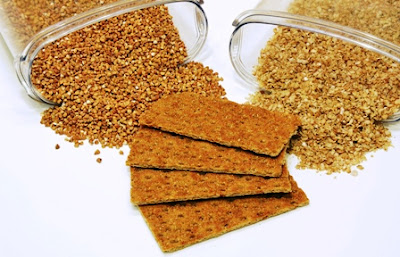Switching on to a gluten-free diet is a big change and will take some time for you and your family members to get adjusted to it. Unlike other dietary restrictions where removal of the culprit food from the diet serves the purpose, removal of gluten requires a lot more efforts. This is because gluten is not only present in wheat, rye, and barley but is also present in hidden form in many other food products. Even a food which is naturally gluten free may get contaminated with gluten during processing.
 |
| Image source: https://upload.wikimedia.org |
While you are learning to adjust yourself to this major change in your diet, you also have to keep yourself prepared to deal with the added pressure of managing social situations. In Northern part of India where wheat is a staple food there a false belief that wheat contains some of the nutrients necessary for good health. So, eliminating wheat from the diet means depriving yourself of all those essential nutrients necessary for healthy living. However, this is not completely true. Wheat does contain some of the essential nutrients, but it is not the only source of these nutrients. They can also be found in other natural foods that can be taken to meet the body's requirement.
So let us have a look on what foods contain gluten.
As mentioned earlier, gluten is present in wheat, rye, and barley. This means any product made from any of these grains needs to be completely avoided on a gluten-free diet. These include but are not limited to:
- Whole wheat flour
- Refined Flour
- Semolina
- Triticale
- Durum Wheat
- Wheat Bran
- Wheat Germ
- Cracked Wheat
Common products that are made using these ingredients:
- Pasta
- Vermicelli
- Noodles
- Cakes
- Muffins
- Pastries
- Cookies
- Wafers
- Bread
- Kulcha
- Pizza Base
- Buns
- Dalia
- Pretzels
- Momos
- Spring Roll Wrappers
- Donuts
- Gujhia
- Panjeeri
- Kachori
- Samosa
- Pani Poori
Hidden sources of gluten
- Soy Sauce
- Vinegar
- Dressings and Marinades
- Fried Foods like French fries, Cutlets
- Granola Bars
- Soups (Especially Cream Soups)
- Cornflakes (Contains malt)
- Some candies
- Seasoned Chips
- Malt
- Modified Starch Foods
- Beer
- Multigrain Tortilla Chips
- Seasonings
- Asafoetida Powder (Packaged one)
- Gram Flour (Besan)
- Artificial Colours
Pl. note: All products that are wheat free are not necessarily gluten free. You must always check with the manufacturer unless it is labelled as gluten free to ensure whether the product is gluten free or not.
Cross Contamination
Cross Contamination occurs when a gluten-free food comes in contact with gluten. It generally occurs via sharing the same cooking space, storing environment or by shared utensils. The following precautions must be taken to avoid any gluten contamination:
- Clean the cooking surface properly. Make sure there is no flour or bread crumbs lying around.
- Maintain a separate set of aluminum, non-stick, wooden, melmoware, plastic utensils, chopping boards for cooking or serving. This is because gluten gets into the pores and does not get removed completely even after washing.
- If using a shared stainless steel utensil make sure to scrub it again using a separate dish wash bar before using it for a gluten free food.
- Always store gluten free foods away from chapatti’s, poori's, flours and other gluten containing food items.
- Wash hands properly before handling a gluten free product.
Other places where cross-contamination may occur:
- Toasters: used for both gluten free and regular bread.
- Flour Sifters
- Colanders
- Fried Foods: Foods fried in the oil used for frying breaded products.
- Condiments
- Besan: usually ground near or in the same mill as wheat. Always buy a gluten free besan
- Oats: Contaminated in fields when they are grown side by side with wheat. Always buy oats labelled as gluten free.
- Non-certified gluten-free food products.
Other Items that may contain gluten
- Drugs and Over the counter medications: Always check with your doctor or manufacturer before taking any medication.
- Vitamins and Supplements
- Herbal Supplements
- Play Dough: Children may unintentionally touch their mouth or eat after handling play dough.
What to eat?
Cutting out gluten from the diet seems to be a very difficult and limiting task. Fortunately, nowadays a lot of gluten free alternatives to regular products are available in the market and are equally delicious and can
be enjoyed by gluten intolerants.
Remember adopting a strict gluten-free diet is the only treatment available for people with gluten-related disorders. However, if proper care is taken in the initial stages when not much harm has occurred to the intestine there is always a possibility that you may outgrow it in future.
If you have any questions on any specific food on whether you can eat or not or any doubt on gluten free diet please leave me a comment below.
In my later blogs, I will share the list of gluten free products and the stores from where they can be purchased.
No comments:
Post a Comment